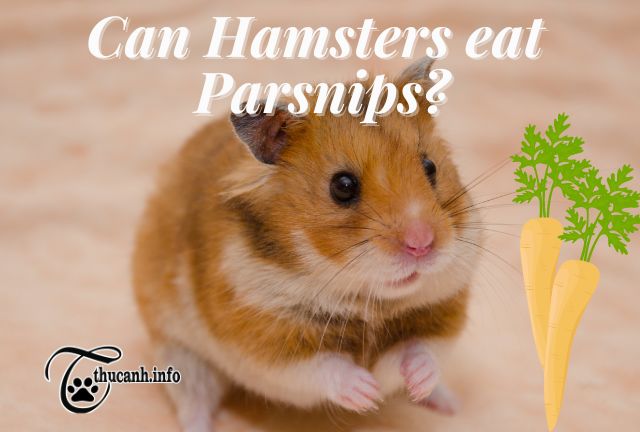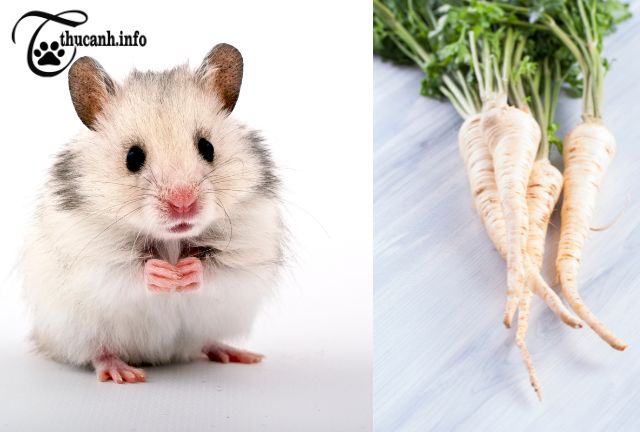Can Hamsters Eat Parsnips? Popular pet hamsters need a balanced diet to be healthy. They mostly consume commercial hamster chow, although you may feed them fresh veggies. Parsnips may intrigue you. The nutritional content of parsnips, health advantages, dangers and side effects, suggested serving sizes, and more will be discussed in this article to answer the question.

Hamsters eat Parsnips good or bad?
1. Can Hamsters Eat Parsnips?
Hamsters may somewhat consume parsnips. Parsnips are a nutritious root vegetable for hamsters. However, introduce new meals slowly and watch for allergies or digestive concerns in your hamster. Remove uneaten parsnips from their cage to avoid spoiling. Give your hamster personalized nutritional guidance from a vet.
2. Parsnip Nutrition for Hamsters
Parsnips are a good source of fiber, vitamin C, and potassium, promoting digestive health and supporting the immune system in hamsters.
Here is a nutrition facts table for 100 grams of Parsnips and its benefits for hamsters:
|
Nutrient |
Amount per 100g | Benefits for Hamsters |
|
Calories |
75 kcal |
Provides energy for daily activities |
|
Carbohydrates |
18g |
Source of essential fuel |
|
Fiber |
4.9g |
Aids digestion and prevents constipation |
|
Protein |
1.2g |
Supports growth and muscle maintenance |
|
Vitamin C |
17.1mg |
Boosts immune system and overall health |
|
Vitamin K |
26.5mcg |
Helps with blood clotting and bone health |
|
Folate |
67mcg |
Supports cell division and growth |
| Potassium | 375mg |
Regulates heart and muscle function |
3. Hamster Parsnip Feeding Risks and Side Effects
Parsnips are nourishing for hamsters, yet there are hazards and adverse effects:
- Natural sugars in parsnips can cause weight gain and health problems if ingested in excess.
- Introducing new foods like parsnips too fast might cause gastric distress and diarrhea in some hamsters.
- Allergic reactions: Hamsters allergic to parsnips may have skin or respiratory issues.
- Large slices of parsnips can choke tiny hamsters due to their tough texture.
- Oxalates: Parsnips contain oxalates, which can block calcium absorption and cause kidney stones.
To keep your hamster safe, feed parsnips in little, well-cooked, mashed pieces and watch for responses. Always consult a vet before feeding your hamster new foods.

The amount of parsnips that hamster should eat
4. How much parsnips should your hamster eat?
Hamsters should eat parsnips moderately. Parsnips should be a pleasure, not a staple. Give your hamster a little piece of parsnip, about the size of its nail, once or twice a week.
Make sure your hamster doesn’t have any digestive or allergy concerns with the new diet. Your hamster may be uncomfortable or you may not know how much parsnip to give. Consult a veterinarian for personalized advice. Your hamster needs a variety, balanced diet to be healthy.
5. Give hamsters parsnip feeding instructions.
To keep your hamster safe and happy with parsnips, follow these guidelines:
- Start with a little: slice if feeding parsnips for the first time. Hamsters need time to acclimatize to new meals.
- Clean: To eliminate dirt and pesticide residue, wash and peel the parsnip. Remove seeds and rough portions.
- Cut into Small Pieces: Cut the parsnip into bite-sized pieces your hamster can munch.
- Quantity limited: pleasure parsnips as a pleasure, not a staple. Overeating might cause intestinal difficulties.
- Monitor Reactions: After eating parsnip, watch for allergies or digestive issues in your hamster.
- Freshness: Serve fresh parsnip and remove uneaten pieces quickly to minimise spoiling.
- Variety in Diet: Parsnips should be eaten with other fruits, vegetables, and hamster pellets.
- Balanced Nutrition: Limit parsnips and other goodies to 10% of your hamster’s diet.
If you’re unsure about introducing parsnips or any new food, visit a vet.
6. Hamster Parsnip Allergies
Hamsters with parsnip allergies may exhibit:
- Skin irritation: Parsnips cause redness, itching, or swelling around the mouth or paws.
- Wheezing, coughing, or breathing problems.
- Diarrhea, bloating, or bowel motions.
- Behavior changes: Lethargy, inactivity, or appetite loss.
- Hamsters scratch or massage their face or body to ease itching.
If your hamster develops any of these symptoms after eating parsnips, stop feeding it and visit a vet. Hamsters have different allergies, so monitoring their reactions to new meals is important.
7. Alternative Hamster Diets to Parsnips
These healthy veggies are alternatives to parsnips for your hamster:
- Carrots: Hamsters love carrots and they include vitamins and minerals.
- Bell Peppers: Vitamin C-rich green, red, and yellow bell peppers offer variety to their diet.
- Cucumbers: Hamsters benefit from cucumbers’ hydration and nutrition.
- Zucchini: is low in calories and high in vitamins and minerals.
- Broccoli: Treat little quantities of broccoli florets.
Introduce different meals slowly and watch your hamster’s reaction. Your hamster needs a balanced diet to stay healthy and happy. If your hamster’s nutrition worries you, visit a vet.

Questions about hamsters and parsnips
8. FAQs
8.1 Can all hamster breeds eat parsnips?
Overall, all hamster breeds can consume parsnips. Most hamster breeds may safely eat parsnips in modest amounts as part of a balanced diet. However, watch your hamster’s behavior to parsnips and other novel meals. Monitor your hamster’s health and visit a vet if you have concerns about their nutrition.
8.2. Should I prepare parsnips before feeding my hamster?
You should boil parsnips before feeding them to your hamster. Making parsnips mushy makes them simpler for hamsters to chew and digest. Raw parsnips might be hard for hamsters to consume. Parsnips may be fed to your hamster by boiling or steaming until cooked. Cool parsnips before feeding them to your pet to avoid burns.
8.3. Can hamsters eat daily parsnips?
Parsnips are healthy, but hamsters shouldn’t eat them daily. Hamsters need a diversified diet to receive all the nutrients they need for good health. Parsnips can be eaten sometimes, but not as a main meal.
A hamster’s health depends on a varied diet of fresh vegetables, fruits, cereals, and commercial pellets. A variety of meals ensures a wide range of nutrients and prevents nutritional imbalances.
Offering tiny amounts of parsnips once or twice a week is enough to pamper your hamster while keeping a balanced diet. Always watch your hamster’s response to new foods and visit a vet if you have diet or health concerns.
8.4. Can newborn hamsters eat parsnips?
Hamster pups have more fragile digestive systems than adults. From 3 to 4 weeks of age, newborn hamsters should be introduced to solid diets. Parsnips may be too young for newborn hamsters.
Providing a balanced diet of commercial hamster pellets and fresh water is crucial for newborn hamsters, who acquire their nutrients mostly from their mother’s milk. Mother’s milk supplies all the nutrients they need to thrive.
You should wait 6–8 weeks to introduce new meals like parsnips to your newborn hamsters. Small, finely cut bits and observe their reaction to the new meal. If you have questions about feeding newborn hamsters a certain meal, see a small animal veterinarian. As your hamsters mature, their health and well-being are essential.
8.5. Can dwarf hamsters enjoy parsnips?
Dwarf hamsters may somewhat consume parsnips. Their diversified diet might include parsnips for minerals and flavor. However, parsnips should only be fed as a treat, not as a main food.
A little bit of parsnip is plenty for dwarf hamsters’ small stomachs. Make sure the parsnip is fresh and mold- and pesticide-free. Wash and chop the parsnip into little pieces for your dwarf hamster.
A balanced diet of fresh veggies, commercial hamster chow, and treats is optimal. This will guarantee your hamster gets all the nutrition it needs to live a long, healthy life. “Can Hamsters Eat Parsnips” article of Thucanh.infor should help.


